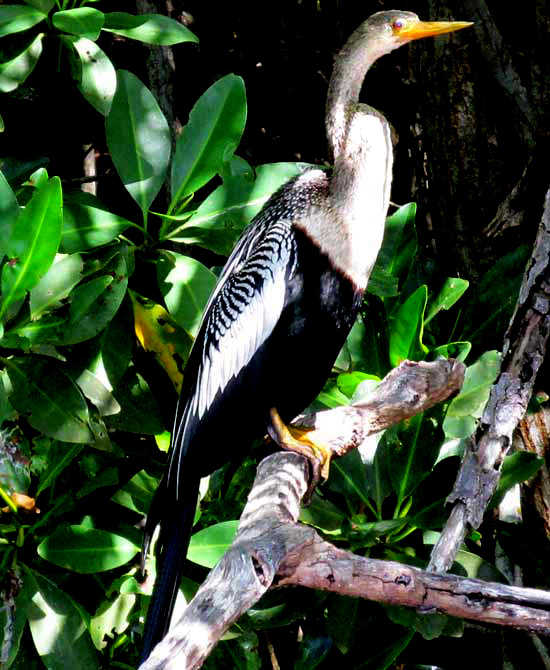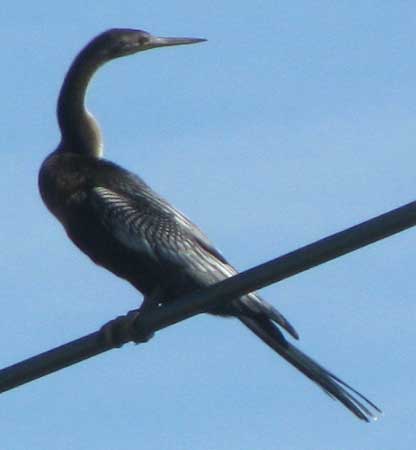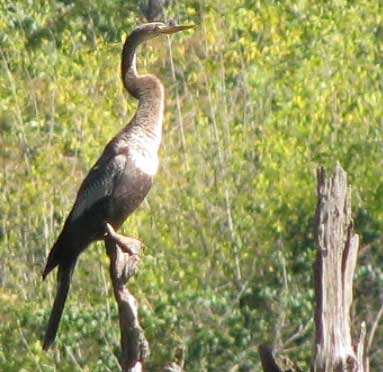Excerpts from Jim Conrad's
Naturalist Newsletter
from the November 6, 2016 Newsletter issued from Rancho Regensis north of Valladolid, Yucatán, MÉXICO
ANHINGA CLOSE-UP
On a boat trip through the estuary of Río Lagartos Biosphere 80kms north of here, we got to within a few feet of an Anhinga -- a cormorant-like bird that's a permanent resident in the Yucatan -- and were able to see details of the bird seldom noticed, shown below:

Note the red eyes, and the yellow bill that narrows to a less-than-yellow, sharp tip. The bills of cormorants are conspicuously hooked. The back's zebra-stripes and the bold, white wingbar are handsome features also lacking on cormorants.
The intensity of the red eye color, the brightness of the yellow bill, and the whiteness of the neck, all vary, depending on the bird's age. After describing in mind-numbing detail the various color variations, Howell says that the species attains adult plumage by the "3d prebasic molt."
from the October 30, 2011 Newsletter issued from Mayan Beach Garden Inn 20 kms
north of Mahahual, Quintana Roo, México
SNAKEBIRD
If you crossed a snake with a bird you'd approximately get what's shown on a power line
beside the mangroves, below:

That's an Anhinga, also known as Snakebird, Darter and Water Turkey, ANHINGA ANHINGA. Anhingas dive into water after fish, frogs, aquatic snakes and the like, and when they surface they float low in the water, maybe even with nothing but their snaky heads emerging from the water. When ours flew off he circled a few times with wings held out at right angles, reminding me of a kid's balsa glider.
People often confuse Anhingas with cormorants. Cormorants belong to the same bird family, but they are placed in a completely different genus. Cormorants have long, hook-tipped beaks while you can see that the Anhinga's bill is sharp.
In the US, Anhingas nest throughout the Deep South but in the winter withdraw to coastal areas. In Mexico they're permanent residents throughout the non-desert lowlands, south to Ecuador and northern Argentina in South America.
from the November 1, 2009 Newsletter, from near Natchez, Mississippi
ANHINGA AT ANNA'S BOTTOM

On Wednesday Karen and I were back in the swamps, this time at Anna's Bottom about ten miles north of Natchez in the Mississippi River floodplain. Permanent open water stands here and there and you never know which water-loving bird will show up. On Wednesday many Double-crested Cormorants, profiled here last week, were flying around, plus there was one snaky-necked Anhinga, ANHINGA ANHINGA, shown sunning on a snag here.
This looks a lot like last week's cormorant, seen at http://www.backyardnature.net/n/b/cormrant.htm.
However, notice that the Anhinga's beak is sharp while the cormorant's was rounded and hooked at the tip. Anhingas spear fish with their sharp beaks, flip them into the air and swallow them head-first. I've read that sometimes the Anhinga's beak skewers the fish so that the bird must return to shore with the fish Shishkabobed on the bill and somehow pry it off.
The Anhinga's neck is so long and slender that Anhingas often are called Snakebirds. They swim with their bodies submerged under the water, with their necks stretched forward. From a distance they can look like snakes with their front ends raised.
Often you see both cormorants and Anhingas sunning themselves with their wings spread against the sun. All the larger birds at Anna's Bottom seemed too nervous for that. I'm guessing that people go there to take potshots at them.
Anhingas are permanent residents in much of the Deep South. They breed in open freshwater wetlands from here through Mexico and Central America into South America.
from the May 23, 2004 Newsletter, from near
Natchez, Mississippi
ANHINGAS SPREADING THEIR WINGS
As if the alligator and softshell turtle weren't enough, Chimney Swifts kept Pipes Lake {~N31.38°, ~W91.16°, elev. ~140ft (~40m)}'s
water splashing as they flew along its surface, scooping up water on the wing. Easier to
watch were the Anhingas, ANHINGA ANHINGA, who between long dives underwater swam with
nothing but their snaky necks and heads above the water's surfaces. Anhingas look a lot
like cormorants, except that their beaks are sharp, not hooked at the end like a
cormorant's, plus there's a lot of white in the anhinga's mostly black wings, while
cormorants have uniformly dark wings.
The most striking thing the anhingas did was to climb onto a snag emerging from the water, spread their wings and tails, and hold them against the incoming sunlight, frequently fanning and shaking them.
While watching the wing-spreading, a question came to mind: Since Anhingas have no more exposure to water than ducks, why do Anhingas spend so much time drying their wings while ducks don't? Gradually I began coming up with an answer as it occurred to me that often I see ducks preening -- smearing waterproofing oil from their preen glands over their feathers -- but I don't remember ever seeing Anhingas doing this. Maybe Anhingas don't have preen glands, I decided. Moreover, since Anhingas are such primitive-looking birds, maybe they don't have preen glands because they came into existence before the bird-world evolved preen glands.
This made such a great story that I almost didn't check it out. However, I did, and found an article entitled "Why do Anhingas spread their wings?" {no longer available}.
There it's stated that Anhingas have unusually low metabolic rates and unusually high rates of heat loss from their bodies. Moreover, they don't have to be wet to exhibit spread-wing postures. Since they typically orient themselves with their backs to the sun, it's deduced that Anhingas spread their wings mainly to absorb solar energy to supplement their low metabolic heat production and to offset partly their unusual high rate of heat loss. Wing-spreading is mainly a thermoregulation behavior, not a drying one. Moreover, the newest insights from genetic sequencing don't appear to support the idea that Anhingas are especially primitive, despite their look.
Still, it's clear that when Anhingas emerge from the water they do want to dry off, for they very plainly agitate their wings and you can see water being shaken off them.
By the way, that nice word "Anhinga" proves to have passed into English from Portuguese, which took it from the Tupi name for the bird, "ayingá." Tupi is a member of the Tupí-Guaraní language stock of coastal and central Brazil and Paraguay. We can deal with that since Anhingas are found from here all the way to southern Brazil.